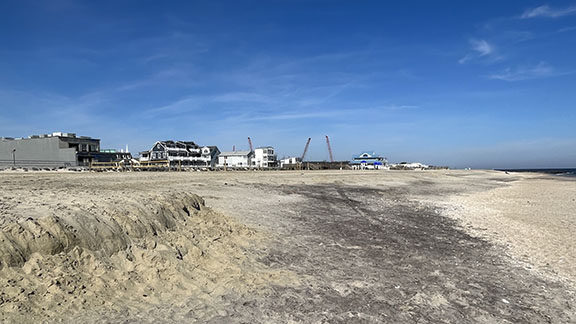
By Sunayana Prabhu
After making landfall on Florida’s southwest coast, causing catastrophic damage to life and property, the record-breaking Category 4 Hurricane Ian surged up the Atlantic Coast and weakened at the Jersey Shore, lashing the Two River area with persistent rainfall for five days.
As hurricane season peaks, The Two River Times reached out to beach towns for an update on the impact of Ian and their preparedness for the remainder of the season.
“We did have minor tidal flooding on certain low-lying areas of town,” said Bill Kane, coordinator of the Highlands Office of Emergency Management, but the borough “fared well as the remnants of Hurricane Ian passed us late last week.”
Coastal flooding and beach erosion remain a lingering threat for beachfront communities. Although the borough was spared flash flooding, it did experience minimal damage and beach erosion. Kane noted that Highland’s public works department “did a great job of keeping the streets clean of any wind debris” and had “just one fire call related to the storm for a down power wire that was fixed by JCP&L within a few hours.”
In an email to The Two River Times, Oct. 10, U.S. Rep. Frank Pallone said, “Highlands will receive $128.7 million to begin the Borough’s flood control project.”
“We all agree we need to repair and rebuild our infrastructure and protect coastal towns from major storms and flooding,” he said. According to Pallone, along with Highlands, the state will also receive $24.4 million to replenish beaches along the Monmouth County coastline that face major erosion.
But not all towns will benefit from federal money. The neighboring beach town of Sea Bright responded with a petition after being dropped from federal funding plans for 2022-23. “Sea Bright was informed we will not be included in this fall’s (beach) replenishment cycle but will be considered if funding allows in the next cycle,” said Sea Bright Borough Council member Samuel Catalano, chair of the Sea Bright beach committee.
To call attention to the problem of costal erosion and vulnerable dunes and to be included in the next cycle of federal funding, the beach committee has been running the petition on Change.org; it is currently signed by 431 Sea Bright residents. “The federal government is footing the bill for other towns, and I believe Sea Bright should get its fair share,” said Catalano.
He said several Sea Bright residents and homeowners’ associations have approached him “concerned with the coastal beach erosion and damage to the protective dunes even before we were informed of being dropped from this year’s cycle.”
Beaches in the Two River area are critical for shore communities. Catalano said the 2022 Sea Bright beach revenue was just over $1 million. “I will fight to make sure (Sea Bright) has everything it needs to thrive.”
Climate change is evident and accelerating. To mitigate the risks and strengthen immediate responses, federal and county agencies have been steering research efforts using grant funding for infrastructure development and to build online toolkits to help citizens assess their vulnerability and protect themselves and their properties.
The National Oceanic and Atmospheric Administration (NOAA) funded and launched Climate Mapping for Resilience and Adaptation (CMRA) in August 2022. The CMRA is accessible at resilience.climate.gov and useful to assess local exposure to climate-related hazards, from wildfires and extreme heat waves to hurricanes and flooding.
According to the website, people can enter a zip code to see how vulnerable their community is and what risks are possible. The website says “understanding exposure” is the first step “in determining which people, property, and infrastructure could be injured or damaged by climate-related hazards, and what options might be available to protect these assets.” The tools offered on the site can serve local communities and government agencies to make a full assessment of their weaknesses and determine how to mitigate risks.
The Monmouth County Sheriff’s Office, along with emergency management officials from all municipalities, regularly issue alerts and emergency preparedness guides for residents.
Although Two River beaches have been spared from major storms this year, the sheriff’s office issued alerts in its August newsletter “to keep in mind that we are in the height of hurricane season.” Residents are encouraged to download the free Monmouth County Sheriff’s Office app for the latest storm-related information and to report damage in the area. Visit mcsonj.org/app for more information.
The article originally appeared in the October 13 – 19, 2022 print edition of The Two River Times.














